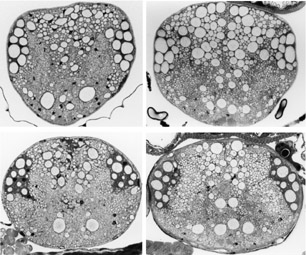

Axon diameter is closely related to several functional properties
including conduction velocity (or electrotonic decrement in passively conducting
axons), synaptic divergence ratio, and current available for electrical transmission.
Larger axons should be faster and better able to activate numerous postsynaptic
neurons. But smaller axons may be more economical, with lower metabolic
costs to support less-extensive axoplasm. Thus large axons might be expected
in pathways where speed, individual reliability, or extensive synaptic output
have selective advantage, while small axons might be favored where such factors
have less adaptive significance. The most extreme examples of evolutionary
specialization affecting individual axonal size are the phylogenetically diverse
occurrences of giant fibers in startle-response pathways.

The cervical connective of flies encompasses several thousand
axons whose cross-sectional areas can differ by more than three orders of magnitude.
A common pattern for axon organization is revealed by the spatial arrangement
of identifiable axons and tracts. These display a fair constancy of size
and position which is apparent through bilateral symmetry within a species,
and less precise but still recognizable similarities among different species.
Most larger axons are concentrated in a dorsomedial tract, while
smaller axons are located ventrally and laterally. The relative sizes
of dorsal-tract axons vary widely among species, so that the proportion of the
connective devoted to the 10 largest axons ranges from less than 5% to more
than 30%. This proportion appears to be greatest among flies with exceptional
flying skill such as asilids (robber flies), bombyliids (bee flies), and syrphids
(hover flies). One pair of "giant" dorsomedial axons (GF
in the figure) is found in most but not all cyclorrhaphans (fruit flies, house
flies, blow flies, and their kin). One or two pairs of very large axons
also occur ventrally in many species; occasionally these large ventral axons
assume "giant" proportions. Many flies possess a coherent ventromedial
bundle of very small (less than 0.5Ám) axons. The number of axons in this
bundle is quite variable; no such tract is apparent in several species of diverse
taxonomic affinities.
These observations suggest that diversity in the dipteran ventral
nervous system may provide an excellent opportunity to explore the genetic and
developmental constraints which influence evolutionary differentiation of neuronal
form, particularly axon diameter.
SOCIETY FOR NEUROSCIENCE ABSTRACTS, 1985.
Also see: Comparative neurobiology 2013 essay / 2006 essay / 1997 essay
Comments and questions:
dgking@siu.edu
SIUC / Zoology / David King
https://dgkinglab.siu.edu/index.htm
Last updated: 21 November 2022